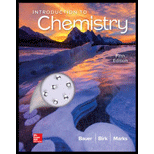
Concept explainers
(a)
Interpretation:
The keyword for the description, “a solution that contains the maximum concentration of the solute dissolved in the solvent as described by its solubility�, is to be identified.
(b)
Interpretation:
The keyword for the description, “a homogeneous mixture of two or more substances in which the solvent is water�, is to be identified.
(c)
Interpretation:
The keyword for the description, “moles of solute per liter of solution� is to be identified.
(d)
Interpretation:
The keyword for the description, “the substance in which another is being dissolved, which is usually present in a larger amount�, is to be identified.
(e)
Interpretation:
The keyword for the description, “a measure of the tendency of the energy of matter to become more dispersed�, is to be identified.
(f)
Interpretation:
The keyword for the description, “the ratio that describes the maximum amount of solute that can be dissolved in a particular solvent to form a saturated solution under specified conditions�, is to be identified.
(g)
Interpretation:
The keyword for the description, “the mass of the solute divided by the mass of the solution and multiplied by
(h)
Interpretation:
The keyword for the description, “a liquid that can be mixed in all proportions�, is to be identified.
(i)
Interpretation:
The keyword for the description, “the passage of solvent molecules, but not those of solute, through a membrane from a less-concentrated solution to a one that is more concentrated�, is to be identified.
(j)
Interpretation:
The keyword for the description, “a property of solutions that depends only on the concentration of solute particles and not on the identity of the solute�, is to be identified.
(k)
Interpretation:
The keyword for the description, “the volume of the solute divided by the volume of the solution and multiplied by
(l)
Interpretation:
The keyword for the description, “the mass of the solute divided by the volume of the solution and multiplied by
Want to see the full answer?
Check out a sample textbook solution
Chapter 11 Solutions
Introduction To Chemistry
- A solution is defined as a homogeneous mixture. Is a small sample of air a solution? Is the atmosphere a solution?arrow_forwardWhat mass of NaHCO3 must decompose to produce 448g of Na2CO3 in 2NaHCO3Na2CO3+H2O+CO2?arrow_forwardIn a dilute solution of sodium chloride in water, the sodium chloride is the: a. solvent. b. solute. c. precipitate. d. reactant.arrow_forward
- A solution containing 43.5g of calcium nitrate is added to a solution containing 39.5g of sodium fluoride. What mass grams of calcium fluoride precipitates? What mass grams of which reactant is in excess?arrow_forwardA student finds that 37.80mL of a 0.4052MNaHCO3 solution is required to titrate a 20.00-mL sample of sulfuric acid solution. What is the molarity of the acid? The reaction equation is H2SO4+2NaHCO3Na2SO4+2H2O+2CO2.arrow_forwardA student weighs out a 4.80-g sample of aluminum bromide, transfers it to a 100-mL volumetric flask, adds enough water to dissolve it, and then adds water to the 100-mL mark. What is the molarity of aluminum bromide in the resulting solution?arrow_forward
- An analytical procedure for finding the chloride ion concentration in a solution involves the precipitation of silver chloride: Ag++ClAgCl. What is the molarity of the chloride ion if 16.80mL of 0.629M silver nitrate the source of silver ion is needed to precipitate all of the chloride ion in a 25.00-mL sample of the unknown? Silver nitrate solution is added to an unknown chloride-ion solution, yielding a precipitate of silver chloride.arrow_forwardssume a highly magnified view of a solution of HCI that allows you to “see” the HCl. Draw this magnified view. If you dropped in a piece of magnesium, the magnesium would disappear, and hydrogen gas would he released. Represent this change using symbols for the elements, and write the balanced equation.arrow_forwardDistinguish between the solute and solvent in each of the following solutions: a saltwater [NaCl(aq)]; b sterling silver (92.5%Ag,7.5%Cu); c air about 80%N2,20%O2. On what do you base your distinctions? Sterling silver is an alloy of 92.5 silver and 7.5 another metal, usually copper.arrow_forward
- Antifreeze is put into the water in an automobile to prevent it from freezing in water. What does the antifreeze do to the boiling point of the water, if anything? Ethylene glycol, HO-CH2-CH2-OH, is the most widely used automotive antifreeze.arrow_forwardThe units of parts per million (ppm) and parts per billion (ppb) are commonly used by environmental chemists. In general, 1 ppm means 1 part of solute for every 106 parts of solution. Mathematically, by mass: ppm=gsolutegsolution=mgsolutekgsolution In the case of very dilute aqueous solutions, a concentration of 1.0 ppm is equal to 1.0 g of solute per 1.0 mL, which equals 1.0 g solution. Parts per billion is defined in a similar fashion. Calculate the molarity of each of the following aqueous solutions. a. 5.0 ppb Hg in H2O b. 1.0 ppb CHCl3 in H2O c. 10.0 ppm As in H2O d. 0.10 ppm DDT (C14H9Cl5) in H2Oarrow_forwardA solution containing 1.63g of barium chloride is added to a solution containing 2.40g of sodium chromate chromate ion, CrO42. Find the mass in grams of barium chromate that can precipitate. Also determine which reactant was in excess, as well as the mass in grams in excess of the amount required by the limiting reactant.arrow_forward
 ChemistryChemistryISBN:9781305957404Author:Steven S. Zumdahl, Susan A. Zumdahl, Donald J. DeCostePublisher:Cengage Learning
ChemistryChemistryISBN:9781305957404Author:Steven S. Zumdahl, Susan A. Zumdahl, Donald J. DeCostePublisher:Cengage Learning Chemistry: An Atoms First ApproachChemistryISBN:9781305079243Author:Steven S. Zumdahl, Susan A. ZumdahlPublisher:Cengage Learning
Chemistry: An Atoms First ApproachChemistryISBN:9781305079243Author:Steven S. Zumdahl, Susan A. ZumdahlPublisher:Cengage Learning
 Introductory Chemistry: An Active Learning Approa...ChemistryISBN:9781305079250Author:Mark S. Cracolice, Ed PetersPublisher:Cengage Learning
Introductory Chemistry: An Active Learning Approa...ChemistryISBN:9781305079250Author:Mark S. Cracolice, Ed PetersPublisher:Cengage Learning
 Introductory Chemistry: A FoundationChemistryISBN:9781337399425Author:Steven S. Zumdahl, Donald J. DeCostePublisher:Cengage Learning
Introductory Chemistry: A FoundationChemistryISBN:9781337399425Author:Steven S. Zumdahl, Donald J. DeCostePublisher:Cengage Learning





